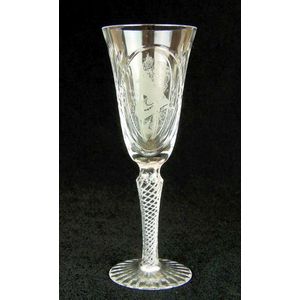Georgian Engraved Floral Cordial Glass, c.1775
You must be a subscriber, and be logged in to view price and dealer details.
Subscribe Now to view actual auction price for this item
When you subscribe, you have the option of setting the currency in which to display prices to $Au, $US, $NZ or Stg.
- Stem - In drinking glasses the stem is that section of the glass that joins the bowl to the foot. In mass produced glasses is usually solid and of cylindrical shape, but in antique drinking glasses it may be long and short and in various styles or with decoration, such as air twist, baluster, collared, faceted, hollow, knopped, teardrop, twisted or incised.
- Bowl - With drinking glasses, the bowl is the hollow section of the glass that holds the liquid. Many glasses were mounted on a stem joined to a foot, others were cylindrical, of tumbler shape. The size and shape of the bowl was determined by the type of liquids they were meant to hold. Shapes used included bell shaped, conical (funnel), bucket shaped, trumpet, cup, ogee, funnel, cylindrical and rounded.
- Engraved Glass - The method of decorating glass by marking the surface with a sharp intrument such as a diamond, metal needle or rotating cutting wheel. As pressure is applied to the surface, best results for engraving are achieved if the glass is of sufficient thickness. In the 19th century etching was used to decorate some table glassware that was too fine to take an engraving tool.
- Georgian - As an English stylistic period, Georgian is usually taken to cover the period from George I (1714) to the Regency of Prince George (1811-20), although the period from 1800 to 1830 is sometimes designated as the Regency period. During the Georgian period the great English cabinetmakers and designers such as Chippendale, Hepplewhite, Adam Sheraton etc., were all active.
Therefore there isn't a single 'Georgian style' as such and to say something is 'Georgian', usually means it was made between 1714 and 1830. This assumes we discount George V and George VI, both being from the 20th century.
The styles popular at the time of each reign were:
George I (1714-1727) saw out the last years of the Baroque period.
George II (1727-1760) reigned during the Rococo period.
George III (1760-1820) saw the last gasp of the Rococo, all of the early Neo-Classic 'Adam style' and most of the later neo-Classic 'Regency style'.
George IV (Prince Regent 1820-1830)encompassed the last of the 'Regency' style.
William IV's reign (1830-1837) was something of a no man's land (stylistically) and he wasn't a 'George' anyway. He covered the last glimmerings of 'Regency' and the start of the 'Victorian' style. - Faceting - Faceting is a technique of removing material from a curved surface, to give a series of flat surfaces but retaining the profile of the original surface.
The technique is most commonly associated with diamond cutting where the various cuts used such as rose cut and brilliant cut, add life and sparkle to the stone, whilst at the same time removing as little of the stone as possible.
Faceting by grinding is also used to decorate glass. The stems of many drinking glasses are decorated by cutting a series of flat surfaces on a circular stem, and hollow vessels such as vases may have faceted surfaces.
In furniture faceting is often applied to legs of tables and chairs, where a circular baluster shaped section is flattened so as to form an octagonal section.
This item has been included into following indexes:
Visually similar items

Lalique 'Barsac' drink wares comprising fifteen champagne glasses & six sherry glasses, with three original boxes. Signed 'Lalique France'. Condition, good, minor use

A pair of heavy Georgian cordial glasses, circa 1810, the glasses with funnel shaped bowls upon facet cut stems to a substantial and polished circular bases. Height 14.5 cm

A Webb Corbett commemorative crystal glass to celebrate the 80th birthday of her Majesty HM Queen Elizabeth the Queen Mother August 4th, 1980 edition No. 164, 22 cm high

Stuart Crystal 'Richelieu' drinks setting for six persons comprising six wine hocks, six claret wines, six low sherbets, & six cordial glasses, having cut strawberries & vines, with a twisted stem.
